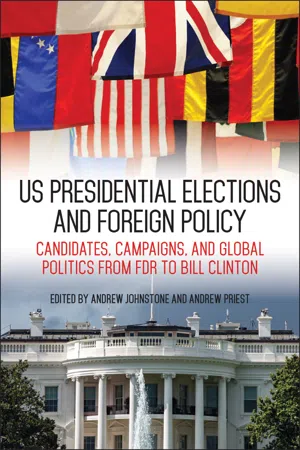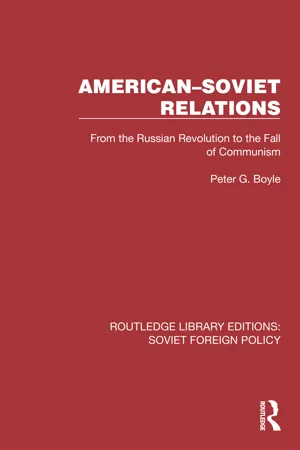History
1952 Presidential Election
The Presidential Election of 1952 in the United States saw Republican candidate Dwight D. Eisenhower defeating Democratic candidate Adlai Stevenson. Eisenhower's military background and promise to end the Korean War contributed to his victory. This election marked a shift in American politics, as Eisenhower's landslide win ended 20 years of Democratic control of the White House.
Written by Perlego with AI-assistance
Related key terms
2 Key excerpts on "1952 Presidential Election"
- eBook - ePub
US Presidential Elections and Foreign Policy
Candidates, Campaigns, and Global Politics from FDR to Bill Clinton
- Andrew Johnstone, Andrew Priest(Authors)
- 2017(Publication Date)
- The University Press of Kentucky(Publisher)
4 Confirming the Cold War Consensus Eisenhower and the 1952 ElectionSteven CaseyA simple counterfactual exercise provides the best way to draw out the significance of the 1952 election. Just imagine for a moment that the two candidates were not Adlai Stevenson and Dwight Eisenhower but Harry Truman and Robert Taft. In 1951, this scenario would have seemed perfectly plausible. Although Truman’s approval ratings were in free fall, dragged downward by the ongoing stalemate in Korea and a series of corruption scandals, he was eligible to run again. The Twenty-Second Amendment, ratified in February 1951, specifically exempted Truman from its stipulations, and, with the vast patronage power of the presidency at his disposal, he might well have been able to manufacture his renomination at the Democratic national convention.1 He had, after all, risen from political death four years before. And now, with no obvious heir, he initially refused to rule himself out of the running.On the other side of the partisan divide, Taft seemed set to romp to the Republican nomination. Intensely ambitious to occupy the same position that his father had held between 1909 and 1913, he had been desperately seeking the top job for years. A nearly man at every Republican national convention since 1940, he had used his sweeping 1950 reelection triumph in the Ohio Senate race to jump-start his new presidential bid. Since then, he had done as much as possible to sew up the nomination, solidifying his close relationship with party bosses and securing the support of as many as four hundred delegates to the upcoming convention.2As Truman and Taft surveyed their election prospects, both men reached a rare meeting of minds: they welcomed the chance to run against each other. In October 1951, the president told reporters that he hoped Taft would be the Republican nominee. A few days later, when Taft returned the compliment, his reasoning was revealing. “I don’t want this to be a mutual admiration society,” Taft explained in a press conference, “but I would like to see President Truman as candidate on the Democratic ticket. We then could go to the country on the real issues between the Republican Party and the Democratic Party.”3 - eBook - ePub
American–Soviet Relations
From the Russian Revolution to the Fall of Communism
- Peter G. Boyle(Author)
- 2022(Publication Date)
- Routledge(Publisher)
9 The Eisenhower Era, 1953–61Eisenhower’s inauguration as president in January 1953 was followed shortly thereafter by Stalin’s death in March 1953 and the Korean armistice in July 1953. The first thaw appeared in the Cold War, which had gone through its most intense period from 1947 to 1952. Eisenhower’s presidency was marked by a succession of thaws and freezes in the Cold War, yet by 1961, as Eisenhower noted in his Farewell Address, the US–Soviet relationship of suspicion and hostility was basically unaltered and the arms race had escalated dangerously. In one sense, Eisenhower’s record was successful, since he ended the Korean War and, in a time of great peril, defended America’s interests and kept the peace at an affordable cost. In another sense, however, was Eisenhower overly cautious in his relations with the Soviet Union, with the result that opportunities for détente and disarmament were missed? This is perhaps the major question which needs to be examined with respect to US–Soviet relations in the Eisenhower era.As a war hero with a very appealing public personality, Eisenhower had powerful assets to enable him to pursue bold initiatives. On the other hand, to an even greater extent than most presidents Eisenhower was under severe political constraints, while at the same time he was not personally inclined to take any gambles on Soviet goodwill, which he believed to be virtually non-existent. Eisenhower won the presidential election in 1952 by a wide margin, but the Republicans gained control of the Senate only by the casting vote of the vice-president and held a slim majority of eight in the House of Representatives. Moreover, a serious political division existed within the Republican Party between the conservatives and moderates. Eisenhower, a moderate Republican, needed to heal the breach with conservative Republicans which had opened up with Eisenhower’s victory for the Republican nomination over the conservative Robert Taft, who became Senate Majority Leader in 1953. Moreover, McCarthy’s power was at its peak and, although Eisenhower despised McCarthy personally, he needed to avoid a confrontation with the McCarthyists, which could split the Republican Party. Against such a political background, an opening to improve relations with the Soviet Union would have been difficult even if Eisenhower had been inclined to attempt it, which essentially he was not.
Learn about this page
Index pages curate the most relevant extracts from our library of academic textbooks. They’ve been created using an in-house natural language model (NLM), each adding context and meaning to key research topics.

